Lessons learned in masonry
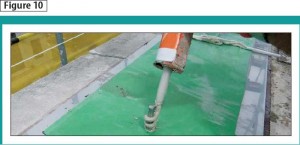
Photo © Pat Conway
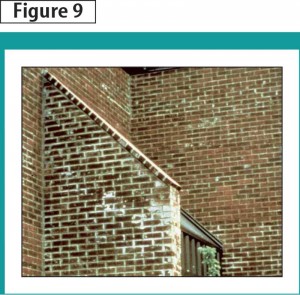
Photo © David Sovinski
Control the air
Uncontrolled airflow has many major consequences, including energy loss through heated air moving through the enclosure and moisture travelling with the airflow. The air barrier must be continuous. Common problems include the area above the suspended ceiling—again, a location where two trades interface.
One should seal all holes in an air barrier. Even a small opening can allow large amounts of moisture to be transferred where no one wants it. A study by the National Research Council Institute for Research in Construction (NRC-IRC) showed air leakage can transfer more than 2000 times the amount of moisture as vapour diffusion alone. (For more information, see National Research Council of Canada (NRC), Division of Building Research, “Building Practice Note No. 54: The Difference Between a Vapour Barrier and an Air Barrier,” by R.L. Quirouette).
Control costs
A cynic might say value engineering is a misnomer, since it often does not bring value and is it not engineering. However, while it is sometimes true what people call ‘value engineering’ simply becomes an exercise in cost-cutting, there are some good cost-to-benefit choices one can make in the masonry enclosure that offer true value at a much lower price.
For example, one should look at modular design. Ensuring the door and window openings occur on a modular scale reduces the need for costly cutting and associated esthetic issues. Lifecycle-costing tools should also be employed. Initial material or system expenses are often overshadowed by future maintenance prices and frequent replacement versus a more durable material.
Masonry cracks
Masonry movement is largely due to two factors: moisture and thermal movement. To help prevent this, one should know the vocabulary. Clay masonry tends to grow, so expansion joints are installed to allow for this movement. Concrete masonry experiences moisture shrinkage, so control joints are also installed to allow for this movement.
One should keep an expansion joint fairly near a corner for performance needs; a good place for a vertical movement joint is the corner side of a close window or door. If one does not provide a joint, nature and physics will simply create one (Figure 7).
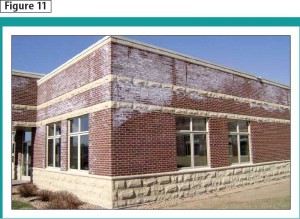
Photo © David Sovinski
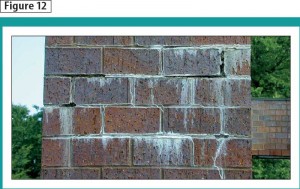
Photo © Pat Conway
If using a steel lintel over a window, mortar should not be used at this joint. Instead, a sealant should be employed since the steel has different movement characteristics and also tends to move due to the load of the brick above (Figure 8).
According to CSA A371-04, Masonry Construction for Buildings, the movement joint location and details are to be specified in the contract documents. One should not ask the mason contractor to locate movement joints––it is not his or her responsibility and he or she may not have enough information to make an informed decision.
Stains and cleaning
By far the most common ‘stain’ is efflorescence. To be precise, this is not technically a stain, but rather the occurrence of soluble salts on the masonry’s surface. The mechanism is fairly well understood, but not always prevented. When moisture enters a masonry assembly, it dissolves soluble salts from the brick, mortar, or other construction sources. One can spend a lot of time and money testing the salt source, but it is generally easier to reduce or eliminate the water penetration and/or increase the masonry’s drying capacity. As this moisture migrates to the masonry’s surface through capillary action, the salts migrate along for the ride. When the moisture evaporates, salts stay behind, visible on the masonry’s surface.
One should use great care with brick rowlock caps. In the case illustrated in Figure 9, even a sloped wall did not stop the water penetration. Instead, one should think of a limestone or precast concrete cap. To further complicate the problem in this circumstance, there was no through-wall flashing beneath. Even with an appropriate cap, one should use through-wall flashing and take care of the final detail by sealing the anchor penetration (Figure 10). Figure 11 shows airborne moisture escaping through an area with a missing air barrier.
Over time, when salts accumulate beneath the masonry’s surface, or subflorescence, they may grow and cause spalling of the masonry surface.
A second stain is a lime run, or calcium carbonate (Figure 12). It appears as a harder substance on the face of masonry, and is caused by repeated moisture flow through a masonry assembly. There must be large amounts of water through masonry for this to occur. This is more difficult to clean, and requires a proprietary cleaner. One should always test on a portion of the building less visible before extensive cleaning. The simple solution is to always find the source of moisture penetration and solve that before cleaning.

Photos © Pat Conway
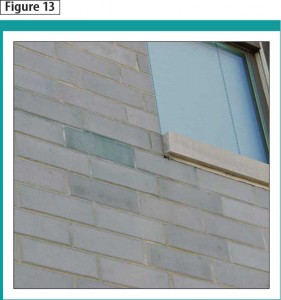
Photo © David Sovinski
Improper cleaning techniques are numerous, but there is one that stands out. Product labels must be read and the manufacturer’s directions followed. If the products are not diluted as directed, or the substrate is not properly treated, then one often sees the product react with the minerals in the masonry, resulting in vanadium or manganese stains (Figure 13).
While it is not a stain, one often wonders why mortar joints do not cure at the same colour. This is often due to inconsistent tooling (Figure 14). Mortar joints should be cured when ‘thumbprint hard.’ If done at inconsistent intervals, the mortar cures at a different colour.
One function of flashing at the brick ledge, or base course, is to prevent rising damp (Figure 15). The rising moisture carries other impurities––in this case, the soil itself.
Communication
During a project’s material selection phase, trade associations such as IMI, material suppliers, or any friends at professional associations can all offer feedback on how materials should be used and detailed. Compatibility issues can be explored and much more.
At the pre-job meetings, one should ensure he or she is very clear on expectations. This is the time to explain what the details on the drawings mean in an unambiguous manner.
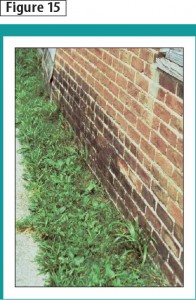
Sample panels are critical. While one tries to communicate his or her expectations in meetings, in specifications, and on drawings, the potential for expensive conflict remains. A mutually agreed on sample panel showing not only the range of material properties, but also workmanship, is vital. If a contractor bids a project with one set of expectations, and a designer has another set of expectations in mind, this sets the stage for disaster. One should explain to the contractor the workmanship on the panel he or she expects for the project as a whole.
Sample panels should not be destroyed until one is completely sure the project is accepted. On a recent project, the sample panel prematurely found its way into the dumpster. Changes in supervisory personnel further complicated the process, and the result was expensive litigation. Keeping the sample panel would have allowed all parties to simply compare the panel to actual construction.
Conclusion
The Canadian construction industry has experienced many rapid, dramatic changes in design, delivery, and performance requirements in the last few years, and can only expect to see accelerated change in the future.
Through all of this, the constant theme of the change is performance-based design, looking at the performance of the entire enclosure as a single entity. The lessons that are learned in this article are just the tip of the iceberg in maintaining a high-performing, cost-effective building enclosure.
David Sovinski is International Masonry Institute’s (IMI’s) national director of industry development. IMI represents an alliance between the International Union of Bricklayers and Allied Craftworkers (BAC) and union masonry contractors. His experience includes masonry project manager, estimator, and architecture and technology teacher at Indiana University Purdue University Indianapolis (IUPUI). Sovinski has a degree in construction management from Purdue University. He can be contacted via e-mail at dsovinski@imiweb.org.







